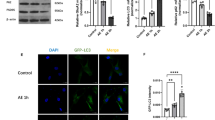Abstract
The aim of this study was to investigate the temporal and spatial relationship between phospho-Rb (ser 795) and neuronal apoptotic death in rats subjected to transient focal cerebral ischemia. We found increased phosphorylation of Rb and translocation from neuronal nucleus to cytoplasm in the penumbra zone at 12 h, 1 day, 3 days and 7 days after middle cerebral artery occlusion (MCAO)/reperfusion, compared with sham-operated controls. At 12 h and 1 day, phospho-Rb appeared to be colocalizated with TUNEL staining in neurons, but staining was not colocalizated at 3 days and 7 days. These results demonstrated that cytoplasmic translocation of phospho-Rb from nucleus of neurons occurs in potential apoptotic neurons in the early stages of ischemia/reperfusion, suggesting that the Rb pathway may only be involved in early neuronal apoptosis and may be not an apoptotic signal in the late stages of transient cerebral ischemia.



Similar content being viewed by others
References
Dirnagl U, Iadecola C, Moskowitz MA (1999) Pathobiology of ischaemic stroke: an integrated view. Trends Neurosci 22:391–397. doi:10.1016/S0166-2236(99)01401-0
Hayashi T, Sakai K, Sasaki C et al (2000) Phosphorylation of retinoblastoma protein in rat brain after transient middle cerebral artery occlusion. Neuropathol Appl Neurobiol 26:390–397. doi:10.1046/j.1365-2990.2000.00264.x
Katchanov J, Harms C, Gertz K et al (2001) Mild cerebral ischemia induces loss of cyclin-dependent kinase inhibitors and activation of cell cycle machinery before delayed neuronal cell death. J Neurosci 21:5045–5053
Osuga H, Osuga S, Wang F et al (2000) Cyclin-dependent kinases as a therapeutic target for stroke. Proc Natl Acad Sci USA 97:10254–10259. doi:10.1073/pnas.170144197
Harbour JW, Dean DC (2000) The Rb/E2F pathway: expanding roles and emerging paradigms. Genes Dev 14:2393–2409. doi:10.1101/gad.813200
Liu DX, Greene LA (2001) Regulation of neuronal survival and death by E2F-dependent gene repression and derepression. Neuron 32:425–438. doi:10.1016/S0896-6273(01)00495-0
Liu DX, Greene LA (2001) Neuronal apoptosis at the G1/S cell cycle checkpoint. Cell Tissue Res 305:217–228. doi:10.1007/s004410100396
Greene LA, Liu DX, Troy CM et al (2007) Cell cycle molecules define a pathway required for neuron death in development and disease. Biochim Biophys Acta 1772:392–401
Padmanabhan J, Park DS, Greene LA et al (1999) Role of cell cycle regulatory proteins in cerebellar granule neuron apoptosis. J Neurosci 19:8747–8756
Park DS, Morris EJ, Padmanabhan J et al (1998) Cyclin-dependent kinases participate in death of neurons evoked by DNA-damaging agents. J Cell Biol 143:457–467. doi:10.1083/jcb.143.2.457
Copani A, Condorelli F, Caruso A et al (1999) Mitotic signaling by beta-amyloid causes neuronal death. FASEB J 13:2225–2234
Park DS, Obeidat A, Giovanni A et al (2000) Cell cycle regulators in neuronal death evoked by excitotoxic stress: implications for neurodegeneration and its treatment. Neurobiol Aging 21:771–781. doi:10.1016/S0197-4580(00)00220-7
Park DS, Morris EJ, Bremner R et al (2000) Involvement of retinoblastoma family members and E2F/DP complexes in the death of neurons evoked by DNA damage. J Neurosci 20:3104–3114
Connolly ES Jr, Winfree CJ, Stern DM et al (1996) Procedural and strain-related variables significantly affect outcome in a murine model of focal cerebral ischemia. Neurosurgery 38:523–531. doi:10.1097/00006123-199603000-00021
Hata R, Mies G, Wiessner C et al (1998) A reproducible model of middle cerebral artery occlusion in mice: hemodynamic, biochemical, and magnetic resonance imaging. J Cereb Blood Flow Metab 18:367–375. doi:10.1097/00004647-199804000-00004
Gavrieli Y, Sherman Y, Ben-Sasson SA (1992) Identification of programmed cell death in situ via specific labeling of nuclear DNA fragmentation. J Cell Biol 119:493–501. doi:10.1083/jcb.119.3.493
Wen Y, Yang S, Liu R et al (2004) Estrogen attenuates nuclear factor-kappa B activation induced by transient cerebral ischemia. Brain Res 1008:147–154. doi:10.1016/j.brainres.2004.02.019
Weinberg RA (1995) The retinoblastoma protein and cell cycle control. Cell 81:323–330. doi:10.1016/0092-8674(95)90385-2
Wen Y, Yang S, Liu R et al (2004) Transient cerebral ischemia induces aberrant neuronal cell cycle re-entry and Alzheimer’s disease-like tauopathy in female rats. J Biol Chem 279:22684–22692. doi:10.1074/jbc.M311768200
Chen B, Wang W (2008) The expression of Cyclins in neurons of rats after focal cerebral ischemia. J Huazhong Univ Sci Technolog Med Sci 28:60–64
Wen Y, Yang S, Liu R et al (2005) Cell-cycle regulators are involved in transient cerebral ischemia induced neuronal apoptosis in female rats. FEBS Lett 79:4591–4599. doi:10.1016/j.febslet.2005.07.028
Sears RC, Nevins JR (2002) Signaling networks that link cell proliferation and cell fate. J Biol Chem 277:11617–11620. doi:10.1074/jbc.R100063200
O’Hare M, Wang F, Park DS (2002) Cyclin-dependent kinases as potential targets to improve stroke outcome. Pharmacol Ther 93:135–143. doi:10.1016/S0163-7258(02)00183-3
Nguyen MD, Mushynski WE, Julien JP (2002) Cycling at the interface between neurodevelopment and neurodegeneration. Cell Death Differ 9:1294–1306. doi:10.1038/sj.cdd.4401108
Wang W, Redecker C, Bidmon HJ et al (2004) Delayed neuronal death and damage of GDNF family receptors in CA1 following focal cerebral ischemia. Brain Res 1023:92–101. doi:10.1016/j.brainres.2004.07.034
Cho BB, Toledo-Pereyra LH (2008) Caspase-independent programmed cell death following ischemic stroke. J Invest Surg 21:141–147. doi:10.1080/08941930802029945
Acknowledgment
This work was supported by National Science Fund for Distinguished Young Scholars (30725019).
Author information
Authors and Affiliations
Corresponding authors
Additional information
Ying Yu and Xiang Luo contributed equally to this work.
Rights and permissions
About this article
Cite this article
Yu, Y., Luo, X., Ren, QG. et al. The Involvement of Upregulation and Translocation of Phospho-Rb in Early Neuronal Apoptosis Following Focal Cerebral Ischemia in Rats. Neurochem Res 34, 1113–1119 (2009). https://doi.org/10.1007/s11064-008-9887-2
Accepted:
Published:
Issue Date:
DOI: https://doi.org/10.1007/s11064-008-9887-2




